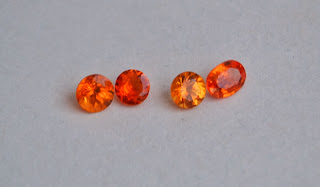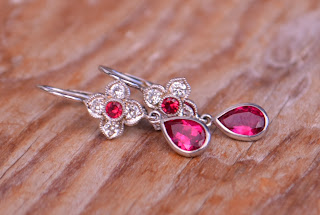I haven’t written much about Mandarin garnets because I don’t
really like orange as a color, and so I’ve ignored this gem for a long
time. But now I think I didn’t do it
justice.
Spessartite,
the garnet group that Mandarin garnet falls under, has only been on the gemstone
market for a little over 10 years. Although
tiny amounts have been found in Germany, California, and Sri Lanka, among other
places for a couple of hundred years, it was so rare that it was considered a collector’s stone. Marketable quantities have only shown up in
Namibia, then Nigeria and Mozambique in the last decade or so. In 2007, there was a find of facet grade Spessartites of beautiful bright color near the town of Loliondo, Tanzania (it's basically a location in the bush, some 10 miles off of a dirt road in
the middle of nowhere). A gemologist friend
of mine travelled there a few years ago and got some nice crystals – a dangerous journey
that necessitated an ample supply of weapons for security.
 |
| Spessarite "Mine" near Loliondo, Courtesy of Jentsch Mineralien |
The
color of spessartite ranges from a light orange to a deep reddish brown, with
the bright and pure neon-color oranges being the most desirable and the most
expensive. The trade has termed them “Mandarin”
garnets. Initially these garnets came
from Namibia, and then Loliondo, Tanzania.
 |
| Here's a sampling of my purchase, the stone with the best color is the second to the left |
Like
most garnets, Spessartites are mostly smaller in size, but 1-3 carats are
available, 5 carats and above are rare. While a brown Spessartite under 1 carat can
run as low as $20/ct, a well cut Mandarin in that size can cost 10 times that
much. Recently prices have been on the
upswing because the mine in Nigeria is no longer up and running. Originally, prices were low but world demand
drove them up very quickly. As a result,
smart dealers that had overbought at the time stashed their parcels away. Indeed this was a good move, because after
staying steady for a few years, prices have recently doubled because supply is
now dwindling. This is in part why I
acquired some pieces.
Design
wise I was surprised how well the bright orange looks in rose gold, and in
particular when pink gems, like mahenge spinel and pink sapphires, are added
into the mix. I also love the
combination of red, orange, and yellow (i.e. yellow sapphires and Burma spinels). Mandarin garnet, as opposed to pyrope garnet,
also has excellent performance in incandescent light. In fact, I find that they look their best
when the light does not hit them directly, but when it is subdued. Then a good quality piece can almost look
neon-orange, despite the occasional tiny white inclusions that are called “sugar”
in industry. That neon color is what
drew me in the most. Extra fine Mandarin
ovals can look more orange from one angle, with flashes of reddish orange from
another angle. It’s really quite
beautiful.
 |
| Mandarin Garnet ring with Burmese Pink Sapphire |
This
not-quite-red yet not light orange color is extremely rare. I’ve seen large parcels from the Loliondo
mines with perhaps just one or two stones that looked like that. In fact, I went through every parcel at my
gem dealer’s office in the smaller, more affordable size, and pulled out all
the most neon pieces I could find. These
days, most mines no longer produce that color at all. Recent reports indicate that only low quality
rough is being offered in Nigeria, and one source has told me that because of
political tensions among locals, the Nigeria mine is no longer operating
now. And so it goes until we find some
more elsewhere on the African continent.









.JPG)
.JPG)

.JPG)





















.JPG)
.JPG)
.JPG)